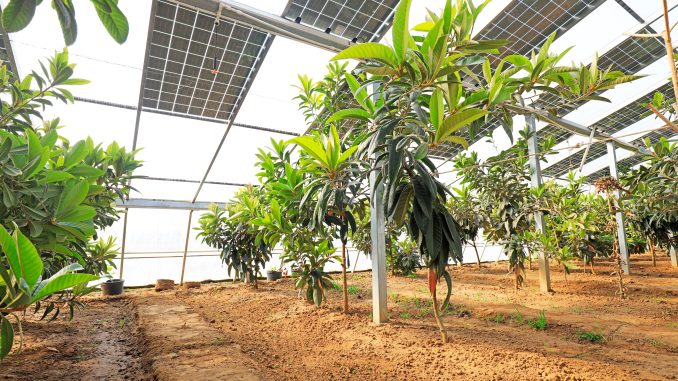
By Sarthak Takyar
Agrivoltaics or agri-PV (APV) in which agriculture and solar generation are done simultaneously, was earlier considered a niche concept, but it is now gaining popularity across the world. In India, its uptake is limited to a few pilot projects.
Vivek Saraf, chief executive officer and founder, SunSeed APV, shares the benefits of APV plants, data on the cost economics, and makes some policy suggestions…
APV plants have several benefits. One, there is dual use of land. There is common civil infrastructure such as fencing, lighting, land grading and storage. Two, there is a high yield of organic horticulture or floriculture due to controlled shading. Three, higher PV generation from bifacial panels is possible due to the elevated installation and higher albedo of the shade net/soil/ crop system. In addition, there is a benefit of possibly lowering panel temperatures due to crop evapotranspiration. Four, there is a 40 per cent reduction in water use owing to reduced evapotranspiration. Five, there are savings in operations and maintenance (O&M) costs as there is no requirement for day-time security and there is dual use of farm personnel for panel cleaning. However, despite these many benefits, high upfront costs are usually cited as a key challenge.
Cost economics
SunSeed APV is implementing two projects, which have five different designs (two tracker based and three fixed-tilt based). The pilot projects are in Parbhani and Nashik and have a capacity of 1.5 MW and 500 kW respectively. According to Saraf, a typical ground-mounted fixed-tilt solar project costs, say, Rs 40 million per MW. The additional APV costs for a 1.25 metre bifacial ground-mounted with fixed tilt project, a 1.75-metre bifacial ground-mounted with tracker project, a 3.75 metre bifacial APV with fixed-tilt project and a 3.75 metre bifacial APV with tracker project will be Rs 3.1 million per MW, Rs 9.4 million per MW, Rs 12.3 million per MW and Rs 15.1 million per MW respectively. The key cost components include mounting structure, bifacial panels, additional land, agricultural infrastructure and design and engineering.

As far as revenue and profit are concerned, the additional electricity generation (per MW) for the four cases compared to the base case is 80,000 units, 400,000 units, 160,000 units and 440,000 units respectively. This leads to an additional annual electricity revenue of approximately Rs 300,000, Rs 1,500,000, Rs 600,000 and Rs 1,650,000 respectively for the four cases. Meanwhile, the additional profits from agricultural activities compared to the base case are Rs 180,000, Rs 405,000, Rs 1,012,500, and Rs 1,125,000.

The equity IRR for all the five cases, including the base case, when the levellised cost of electricity (LCoE) is fixed at Rs 3.75 per unit, is 10 per cent, 10.5 per cent, 12.75 per cent, 11 per cent and 13.25 per cent. For the economics to work, Rs 3.75 per unit of tariff has been assumed. Meanwhile, if the equity IRR is fixed at 10 per cent, the LCoE (Rs per kWh) for all the five cases is Rs 3.75, Rs 3.70, Rs 3.35, Rs 3.60 and Rs 3.25 respectively. “Based on these calculations, the 3.75 metre bifacial tracker-based APV project has the best economics based on equity IRR and LCoE even though the initial cost is the maximum. This is because of the maximum revenue and profits earned from electricity generation and agricultural produce. While the data of costs is based on the actual pilot projects being implemented, the revenue data is theoretical and has to be proved post the commissioning of the pilot,” says Saraf.

With the 3.75 metre APV project, high-value crops such as grapes, cherry tomatoes and coloured capsicums can be grown, hence resulting in the maximum agriculture profits. The importance of trackers should be underscored. The second-best economic case (based on equity IRR and LCoE) is of a 1.75 metre bifacial ground-mounted with tracker project. And after that, a 3.75 metre bifacial APV with fixed-tilt project is more economical. Based on the business model that the developer of the 3.75 metre bifacial tracker-based APV project will keep 85 per cent of the agricultural profit and 15 per cent will go to the farmer, the calculation shows that the marginal farmer’s income gets doubled.

The way forward
Currently, there are no subsidies available for APV plants. “We would like to see a good legal framework in place between the farmer and the developer. In addition, a clear water use policy will be appreciated, as currently, when the land use changes from agriculture to solar, ground water cannot be utilised. However, this is not possible with APV as agriculture will be done simultaneously. The subsidies available for protected cultivation and drip irrigation should continue. Moreover, some capital subsidy can be provided initially to incentivise adoption of APV, and the government is perhaps working on a pilot policy in this space,” says Saraf.



